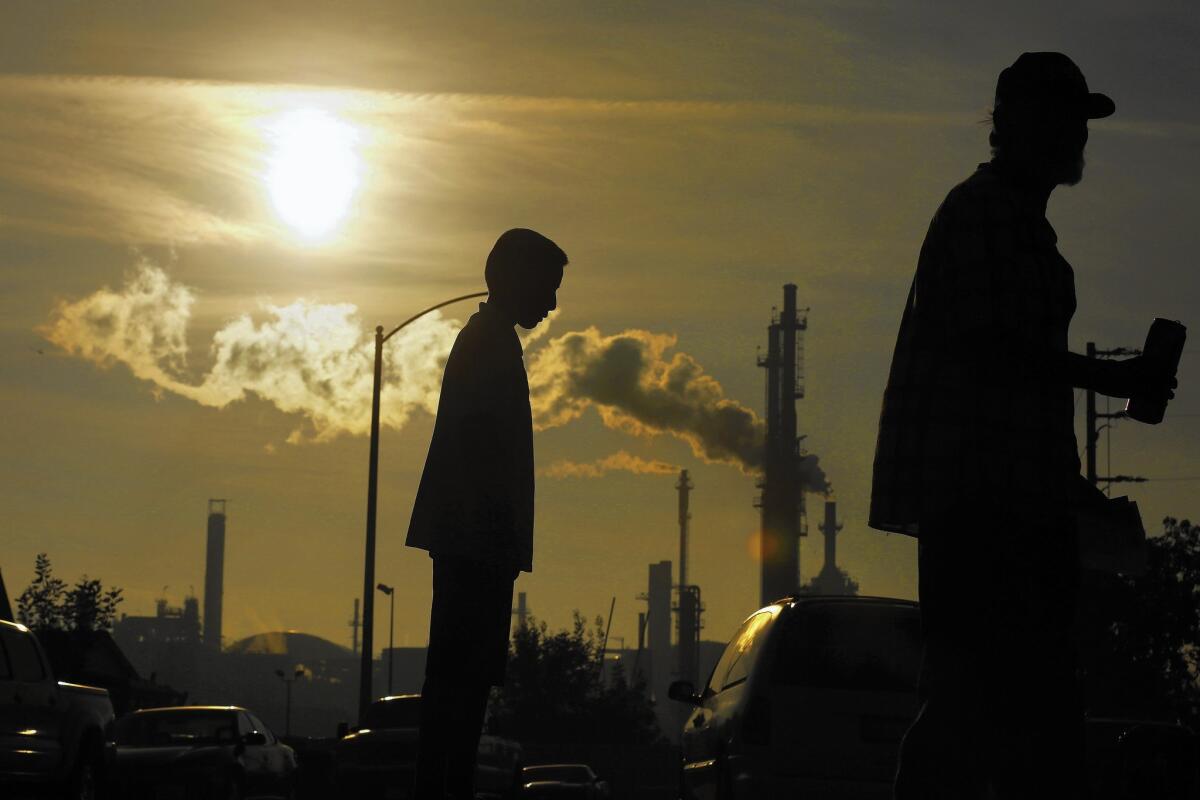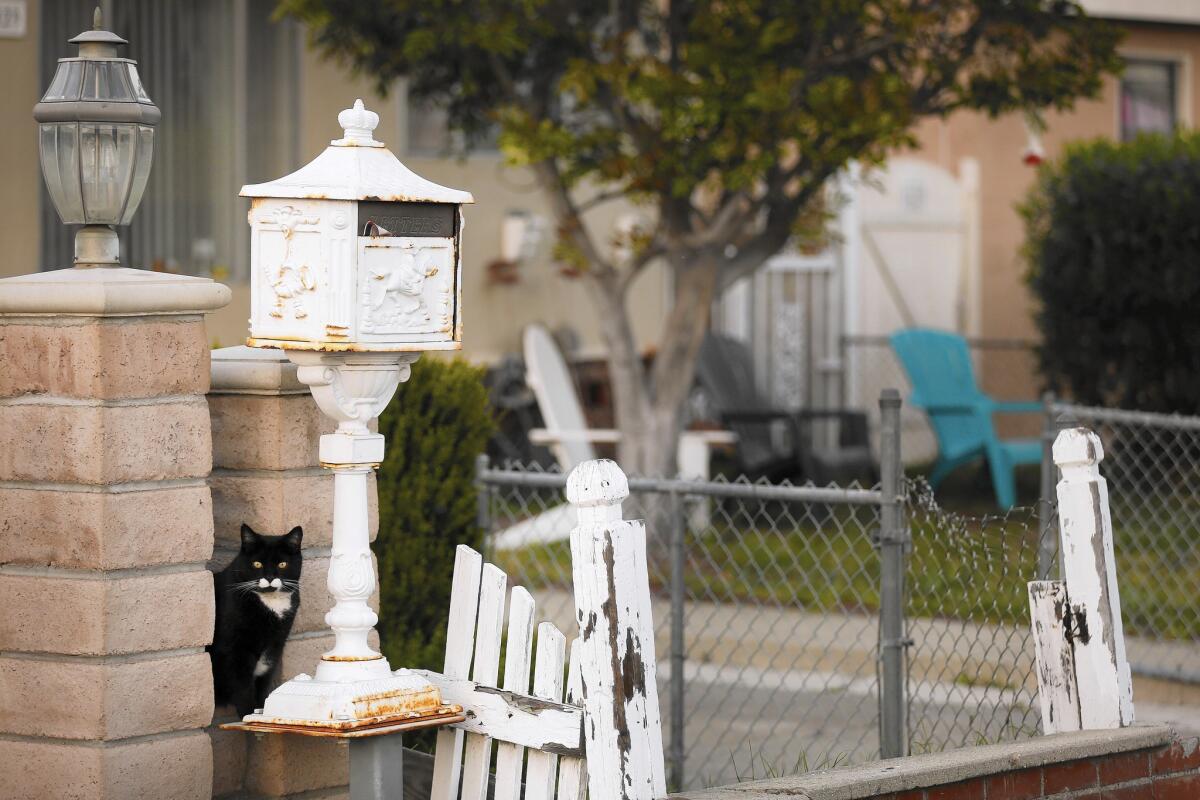A Wilmington neighborhood is an island in a sea of petroleum

- Share via
The chemical train didn’t come this morning.
So Gerardo Juarez tinkers in his frontyard in Wilmington, talking to his neighbors, trimming his nails with a pocket knife. He throws buckets of laundry water on his lawn to keep it lush for his grandchildren’s soccer games.
Juarez, 64, lives on a block of small houses painted peach, periwinkle and baby blue, where many of the residents are related, and most are grandparents by now. They harvest nopales and nectarines from their yards. Some watch TV tuned in from roof antennas. Every July 4, they gather in the street to eat and drink and watch the young ones light sparklers and Piccolo Petes.
But this piece of the middle class has always been hitched to a towering caveat at the end of the block.
Upwind and right next door, the Phillips 66 refinery looms over the neighborhood, a skeletal Goliath of pipes, tanks, valves, boilers, stacks, columns and cracking units. It hisses, clanks, fumes and lofts its own clouds into the sky.
While the refinery’s flares don’t ignite as often as they used to, the great organism exhales in many places.
Juarez can see the facility’s breath this clear morning. Rising gas and heat create strange blurry spots in the interstitial spaces. High above, steam pours out of stacks nearly 200 feet in the air.
But it’s an area he cannot see, just over the wall, a little more than a hundred yards away, that he worries about most.
For the last couple of years there, about twice a week, trains have pulled up to long, pill-shaped tanks. Juarez can see only the tops of the tanker cars, but soon after they arrive, he hears a high-pressure hiss, and a powerful smell of fertilizer drifts into his neighborhood.
The odor makes him dizzy and nauseated, and he rushes inside at the first hint of it.
When he steps back out later, he finds little yellow dots on the black paint of his car. He has to use wax to get rid of them.
He can only imagine what 37 years of breathing this air might one day germinate in his body.
But he has no plans to leave.
::
The neighborhood is an island in a sea of petroleum.
Four short blocks, 59 homes, wedged between the Harbor Freeway and the 424-acre refinery.
In the broader landscape of Wilmington — one of California’s most heavily industrialized zones — residents are exposed to all that belches and wafts from recyclers, chemical plants, scrap yards, six oil refineries, hundreds of oil wells, trucks, trains, and cargo ships in the harbor.
In Juarez’s nook of west Wilmington, the refinery came long before the houses, a consequential point even today.
The Union Oil Co. of California built the original refinery in 1919 between the Bixby Slough and the port, on a hill rising to the Palos Verdes headlands.
The burgeoning car culture and the oil boom fed each other, and fed suburban growth. Neighborhoods soon were pushing into working oil fields across the region, and next to the refineries around the port and the South Bay. Oil workers bought many of the homes.
The small bungalows next to the Union Oil refinery were built in the World War II era, Juarez’s in 1944.
Wilmington’s proximity to the commercial docks, union halls, railroads, fish canneries and manufacturers made it a working-class hub, a natural place for immigrants to start in America.
Juarez and his younger brother Gustavo arrived from the ranch lands of Michoacan, Mexico, in 1976. Gerardo got a job fabricating windows in Gardena. Within three years, he, Gustavo and his brother-in-law were shopping together for a home and found a great deal for a 1,000-square-foot bungalow at 1442 F Street. They had saved just enough for the 20% down payment — $13,000 — and moved their three families in.

Just one house and a narrow weedy easement lay between them and the refinery. Juarez knew the air was polluted. But at that time, all of Los Angeles lay smothered in brown smog much of the year.
He had other factors to consider.
The street was quiet. The raised freeway, which had sliced through the neighborhood in 1956, kept at bay the chaos that rattled the rest of the town. Gangs didn’t bother them. No one tagged their walls or broke into their cars. They liked the nearby school.
Juarez went on to drive a forklift at the Bumble Bee tuna cannery in Santa Fe Springs for 22 years. He bought out Gustavo and his brother-in-law and owned the house himself.
Gustavo moved across the street, and their children grew up riding bikes over the dirt track jumps and berms they’d built in the easement.
This was the California Juarez had hoped to offer his kids.
Not that the family could ignore what was behind the fence. It was an ever-evolving system, with new components popping up all over, old ones going dormant. On normal days, it was loud and smelly, like an enormous lawn mower idling next door.
See more of our top stories on Facebook >>
When a particularly noxious gas came over the fence, the neighbors complained. But nothing much ever happened.
“Inspectors come for a few minutes, and leave,” Juarez says.
In 1999, an explosion sent up a cloud of black smoke that could be seen across the county. The Harbor Freeway was closed and the neighborhood was evacuated because of the poisons in the air.
They started working with environmental groups such as Communities for a Better Environment and the Coalition for a Safe Environment, and pressure in Sacramento and the air quality district offices in Diamond Bar eventually led to tighter restrictions.
Now the refineries can flare — burn excess gas into the atmosphere — only during emergencies and maintenance, and they have to monitor what compounds are released.
Still, emissions vary wildly depending on how many flaring events they have.
The year the air district started the monitoring, 2006, Phillips 66 reported that the refinery’s flares released 27,607 pounds of particulate matter, nitrous oxides, reactive organic gases, carbon monoxide and sulfur dioxide. The next year, the reported number was down to 2,335 pounds.
It’s gone up and down ever since.
Last year, the company said the refinery released 76,744 pounds, the worst year on record.
None of this accounts for all the other gases and particulates spilling out of hundreds of different pressure-release valves, pipes and stacks throughout the facility.
The Environmental Protection Agency last year ordered all refineries to start monitoring for dangerous benzene at the fence line, and to take new measures to limit the release of other gases. The industry is fighting in court to stave off those rules.
For the neighbors, these emissions have always been an insidious foe, because they can never know the damage they are causing.
When two elderly neighbors died of cancer not long ago, Juarez had to wonder if it was the benzene in the air, or just the natural course of aging.
Did the sulfur compounds pouring out of the flares cause his two nieces’ respiratory problems? Or was it the diesel exhaust from the freeway? Or both? Or neither?
And that woman on the next block with lung cancer: Did the ammonia in the air damage her lungs? Impossible to know. She smoked cigarettes — not heavily, but enough.
As for himself, he worries that his headaches might be a prelude to something much worse.
On Arabic Street, Claudia Martinez, 32, has been struggling with asthma and anemia. She went to a specialist two weeks ago and says she was told she had a non-acute form of leukemia.
She recalls one night standing outside in a group when the flares were going. A refinery worker who lived in the area passed by and warned them: “When that flare is on, you need to go inside.”
Back on F Street, Guadalupe Cuautle, 58, says she is having an allergic reaction and wipes her eyes and runny nose. Though the train didn’t come, an acrid, egg-like smell is thick.
Fourteen years ago, she went to Tijuana to have a uterine fibroid removed.
She says the doctor asked what type of chemicals she works with. Cuautle told her she worked in a restaurant.
Since then she’s had three more surgeries to remove smaller tumors and cysts in her reproductive tract.
Unlike Juarez, she wants out.
She just needs the value of her house to rise so she can buy something decent elsewhere.
Juarez is dubious that the refinery will get significantly cleaner. Even with the monitoring, he figures the oil company would rather just pay fines than fix the infrastructure necessary to significantly clean up the air.
On Friday, Southern California’s air quality board voted against taking stronger measures, backed by state officials and environmentalists, to reduce smog-forming nitrogen oxide emissions from refineries. Instead it confirmed an earlier vote to adopt a weaker, industry-backed plan.
Phillips 66 officials say they work each day to ensure that they don’t emit more than their permits allow.
Juarez still feels that the advantages of his house outweigh the risks.
“The house helped my family move forward,” he says.
He simply can’t afford a piece of suburbia anywhere else.
And he’s done so much work on the house, with his own hands, it feels like a part of him.
He installed marble floors and repaved his driveway and walkway, inlaying river cobble on the steps. He babies his garden down to the plastic pink flamingos roosting in his calla lilies.
Double-pane windows now dampen the refinery’s rumbling at night.
Inside, it’s almost as if the giant caveat is not there.
ALSO
Editorial: Is AQMD easing up on smog?
Power grab topples another defender of California’s environment
Southern California air board moves to weaken pollution regulation







